Synopsis
The film opens in a courtroom with the prosecutor laying the government's case against a syndicate of racketeers with names like Joseph B, Sam E, etc. Once the prosecutor starts to go into the time line of the case, the film dissolves into short segments showing the racketeers at work, how they organized themselves, bought up steers at inflated prices and forced butchers to distribute the illicit beef. They are caught, however, when one housewife is told that she can't buy a steak with her ration cards, but a woman after her does without them.
The butcher is taken by the OPA (Office of Price Administration) and interrogated. He is asked what his son in Africa would think if he knew his father were cavorting with saboteurs, and spills the beans about his accomplices. When the lawyer comes back, he looks to the audience and tells them that they too must not buy goods above the rationed price, and report it if they see it. A closing note tells the audience that everyone in the film is a law-abiding citizen who volunteered to act in the movie to educate the public about black marketing.
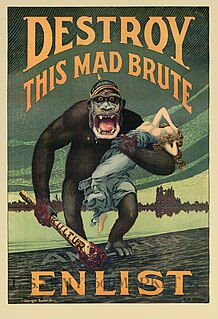
Propaganda is communication that is primarily used to influence or persuade an audience to further an agenda, which may not be objective and may be selectively presenting facts to encourage a particular synthesis or perception, or using loaded language to produce an emotional rather than a rational response to the information that is being presented. Propaganda can be found in news and journalism, government, advertising, entertainment, education, and activism and is often associated with material which is prepared by governments as part of war efforts, political campaigns, health campaigns, revolutionaries, big businesses, ultra-religious organizations, the media, and certain individuals such as soapboxers.
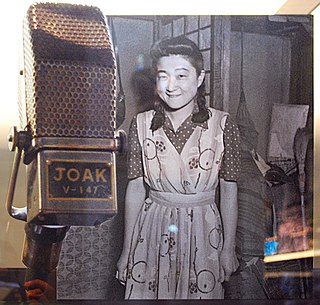
Iva Ikuko Toguri D'Aquino was a Japanese-American disc jockey and radio personality who participated in English-language radio broadcasts transmitted by Radio Tokyo to Allied troops in the South Pacific during World War II on The Zero Hour radio show.

Black propaganda is a form of propaganda intended to create the impression that it was created by those it is supposed to discredit. Black propaganda contrasts with gray propaganda, which does not identify its source, and white propaganda, which does not disguise its origins at all. It is typically used to vilify or embarrass the enemy through misrepresentation.

Rationing is the controlled distribution of scarce resources, goods, services, or an artificial restriction of demand. Rationing controls the size of the ration, which is one's allowed portion of the resources being distributed on a particular day or at a particular time. There are many forms of rationing, although rationing by price is most prevalent.
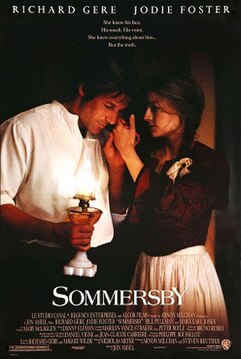
Sommersby is a 1993 American romantic period drama film directed by Jon Amiel from a screenplay written by Nicholas Meyer and Sarah Kernochan, adapted from the historical account of the 16th century French peasant Martin Guerre. Based on the 1982 French film The Return of Martin Guerre, the film stars Richard Gere and Jodie Foster, with Bill Pullman, James Earl Jones, Clarice Taylor, Frankie Faison, and R. Lee Ermey in supporting roles. Set in the Reconstruction era following the American Civil War, the film depicts a farmer returning home from the war, with his wife beginning to suspect that the man is an impostor.

The Committee on Public Information (1917–1919), also known as the CPI or the Creel Committee, was an independent agency of the government of the United States under the Wilson administration created to influence public opinion to support the US in World War I, in particular, the US home front.

The United States Office of War Information (OWI) was a United States government agency created during World War II. The OWI operated from June 1942 until September 1945. Through radio broadcasts, newspapers, posters, photographs, films and other forms of media, the OWI was the connection between the battlefront and civilian communities. The office also established several overseas branches, which launched a large-scale information and propaganda campaign abroad. From 1942 to 1945, the OWI revised or discarded any film scripts reviewed by them that portrayed the United States in a negative light, including anti-war material.
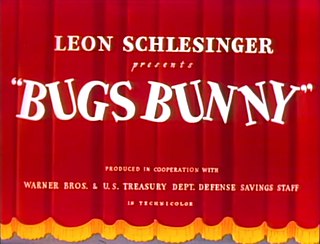
"Any Bonds Today?" is a song written by Irving Berlin, featured in a 1942 animated propaganda film starring Bugs Bunny. Both were used to sell war bonds during World War II.

That Hamilton Woman, also known as Lady Hamilton, is a 1941 black-and-white historical film drama, produced and directed by Alexander Korda for his British company during his exile in the United States. Set during the Napoleonic Wars, the film tells the story of the rise and fall of Emma Hamilton, dance-hall girl and courtesan, who married Sir William Hamilton, British ambassador to the Kingdom of Naples. She later became mistress to Admiral Horatio Nelson.

Confessions of a Nazi Spy is a 1939 American spy political thriller film directed by Anatole Litvak for Warner Bros. It was the first explicitly anti-Nazi film to be produced by a major Hollywood studio, being released in May 1939, several months before the beginning of World War II and over three years before American entry into the war.

The United States home front during World War II supported the war effort in many ways, including a wide range of volunteer efforts and submitting to government-managed rationing and price controls. There was a general feeling of agreement that the sacrifices were for the national good during the war.

The Negro Soldier is a 1944 documentary film created by the United States Army during World War II. It was produced by Frank Capra as a follow up to his successful film series Why We Fight. The army used the film as propaganda to convince black Americans to enlist in the army and fight in the war. Most people regarded the film very highly, some going as far as to say that The Negro Soldier was "one of the finest things that ever happened to America". Due to both high reviews and great cinematography, The Negro Soldier proved to be a breakout film influencing army members and civilians of all races. In 2011, it was chosen to be preserved in the National Film Registry of the Library of Congress.

Gracias Amigos was a 1944 propaganda short produced by the Office of the Coordinator of Inter-American Affairs to educate the American public about the contributions of Latin America during World War II.
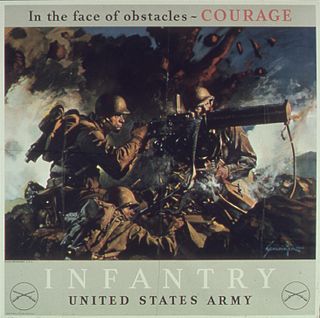
During active American involvement in World War II (1941–45), propaganda was used to increase support for the war and commitment to an Allied victory. Using a vast array of media, propagandists instigated hatred for the enemy and support for America's allies, urged greater public effort for war production and victory gardens, persuaded people to save some of their material so that more material could be used for the war effort, and sold war bonds. Patriotism became the central theme of advertising throughout the war, as large scale campaigns were launched to sell war bonds, promote efficiency in factories, reduce ugly rumors, and maintain civilian morale. The war consolidated the advertising industry's role in American society, deflecting earlier criticism. The axis leaders were portrayed as cartoon caricatures to make them appear foolish and idiotic.
Wartime Nutrition is a 1943 short film. One of the Allied propaganda films of World War II it urged civilians on the United States home front to eat healthier and follow the wartime ration guidelines.

Britain re-created the World War I Ministry of Information for the duration of World War II to generate propaganda to influence the population towards support for the war effort. A wide range of media was employed aimed at local and overseas audiences. Traditional forms such as newspapers and posters were joined by new media including cinema (film), newsreels and radio. A wide range of themes were addressed, fostering hostility to the enemy, support for allies, and specific pro war projects such as conserving metal and growing vegetables.

A black market, underground economy, or shadow economy is a clandestine market or series of transactions that has some aspect of illegality or is characterized by noncompliance with an institutional set of rules. If the rule defines the set of goods and services whose production and distribution is prohibited by law, non-compliance with the rule constitutes a black market trade since the transaction itself is illegal. Parties engaging in the production or distribution of prohibited goods and services are members of the illegal economy. Examples include the illegal drug trade, prostitution, illegal currency transactions, and human trafficking. Violations of the tax code involving income tax evasion constitute membership in the unreported economy.
World War II changed the possibilities for animation. Prior to the war, animation was mostly seen as a form of family entertainment. The attack on Pearl Harbor was a turning point in its utility. On December 8, 1941, the United States Army began working with Walt Disney at his studio, stationing Military personnel there for the duration of the war. The Army and Disney set about making various types of films for several different audiences. Most films meant for the public included some type of propaganda, while films for the troops included training and education about a given topic.
During World War II, the entertainment industry changed to help the war effort. Often the industry became more closely controlled by national governments, who believed that a supportive home front was crucial to victory. Through regulation and censorship, governments sought to keep spirits high and to depict the war in a positive light. They also found new ways to use entertainment media to keep citizens informed.
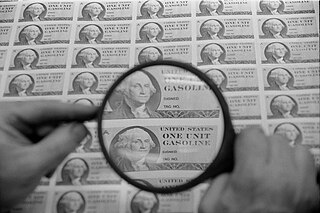
Rationing is the controlled distribution of scarce resources, goods, or services, or an artificial restriction of demand. Rationing controls the size of the ration, which is one person's allotted portion of the resources being distributed on a particular day or at a particular time.
















